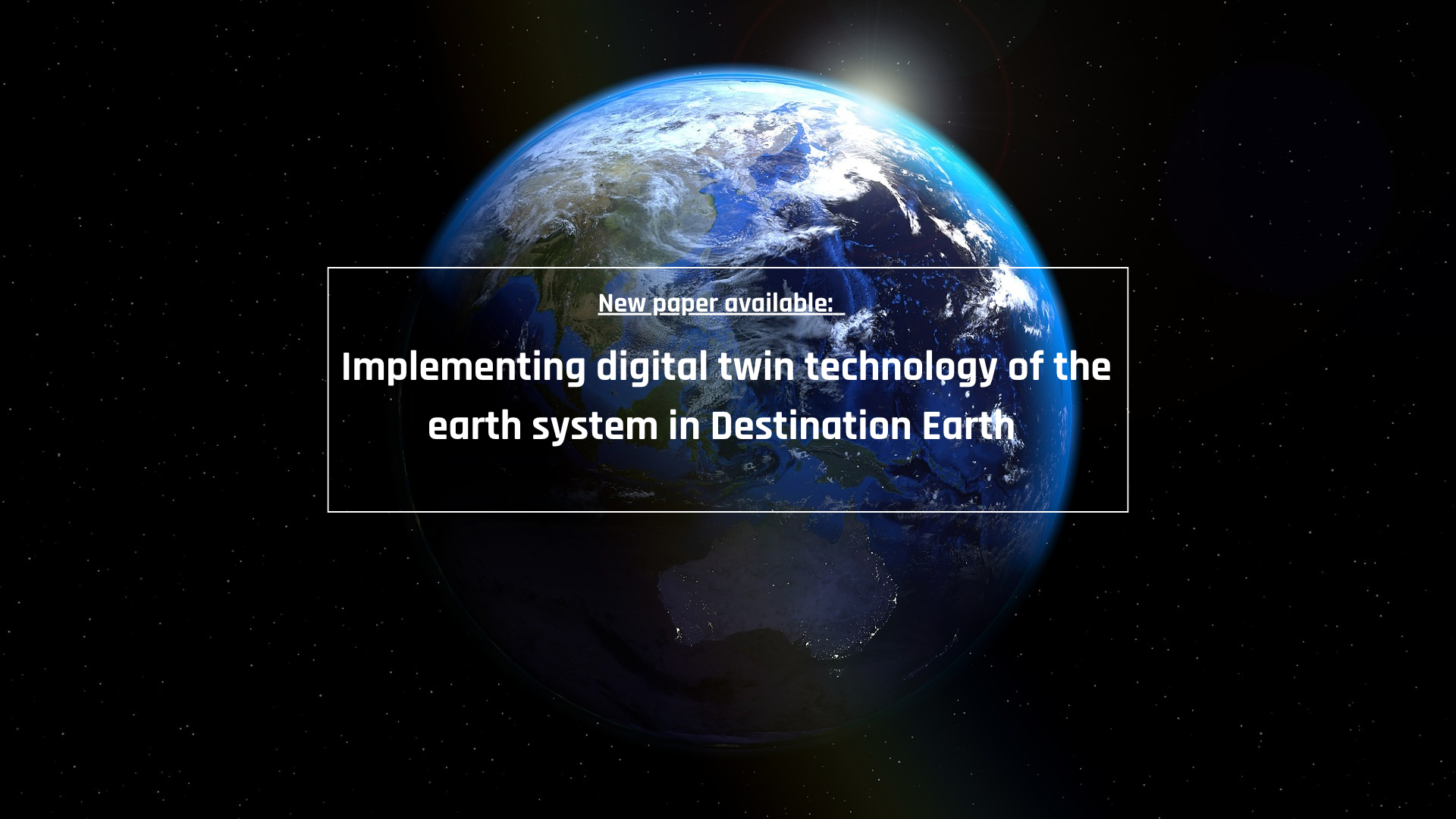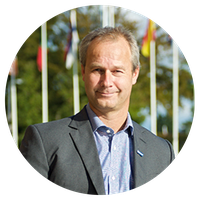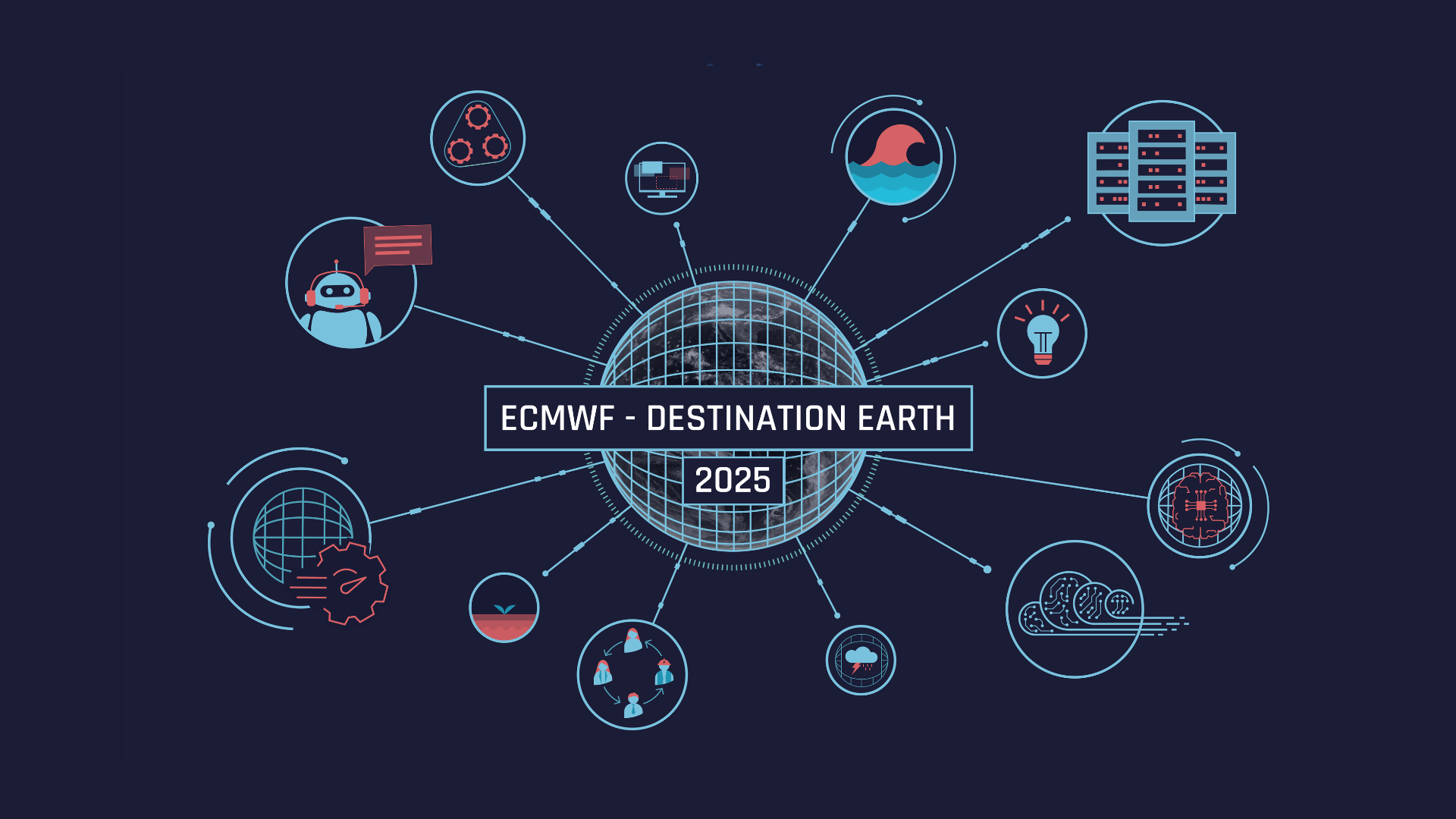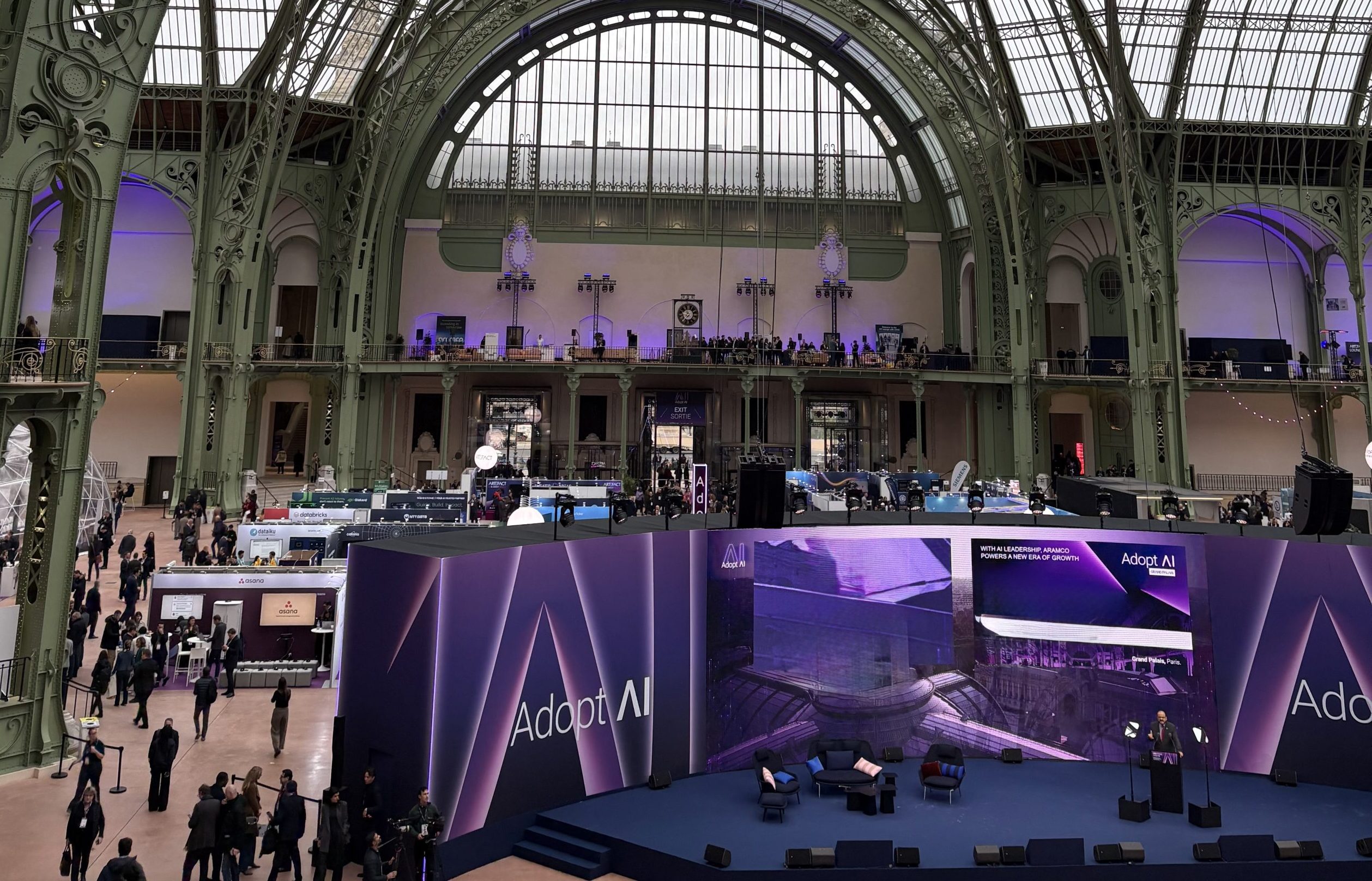
A team of scientists from the European Centre for Medium-Range Weather Forecasts (ECMWF) and many institutions across Europe involved in the development of Destination Earth digital twins have authored a new scientific paper that has recently been published in the Journal of the European Meteorological Society. The paper summarizes the achievements of the first large-scale effort to develop Earth system digital twin technology as part of the flagship initiative of the European Commission DG CNECT, and the deployment of novel modelling and programming paradigms on some of the world’s most powerful computing systems, provided by the EuroHPC Joint Undertaking.
The paper led by Digital Technology Lead for Destination Earth at ECMWF Nils Wedi* reviews what has been achieved in Earth system digital twin of Earth technology during the first phase of the initiative (2022-2024). The paper outlines the key elements of earth system digital twin technology and key objectives of the second, ongoing phase of the initiative (2024-2026). The authors also acknowledge the solid background of European efforts and investments in science, technology and supercomputing that has led to a world-class weather and climate prediction infrastructure, enabling the fast development of DestinE.

“It is complex to bring all the pieces together, because there are so many aspects to it, but it is exciting to document this truly European achievement with the many colleagues across our Member and Co-operating States who contributed in an incredibly short period of time. What was a vision a couple of years ago is now a running and scalable system producing encouraging results. The article looks back to what we’ve already done and outlines future developments,” said Nils Wedi.
Key achievements during Phase I
The paper reviews the advances made in the Digital Twin Engine and the first two, high priority digital twins of Destination Earth, developed by ECMWF in close collaboration with more than 100 institutions from 25 countries.
The DTE is the central orchestration framework for DestinE, managing the complex simulation workflows, huge data output and user interaction in the complex distributed high-performance computing (HPC) environment provided by EuroHPC JU.
This novel software infrastructure has contributed to adapt and optimize state-of-the-art Earth system models – such as IFS coupled to two different ocean models NEMO and FESOM, linking to on-demand regional modelling building on the ACCORD system, and ICON – to the CPU-GPU supercomputing architectures of the EuroHPC JU.
The DTE has also been instrumental for executing routinely km and sub-km scale simulations across the EuroHPC systems provided: LUMI, Leonardo and MareNostrum 5 and handling the vast datasets produced while connecting the DT data to the Data Lake, implemented by EUMETSAT, and the DestinE platform implemented by ESA. This innovative Big Data management approach foresees the streaming of Earth system data for sector specific applications directly from the digital twins, allowing dynamic data tailoring for the user needs.
The Polytope service, part of the DTE, is an advanced feature for extraction of selected data from large hypercubes of digital twin data. This reduces the access time to sub-selected native DT data and ensures interoperability with the growing python-based data access ecosystems.
The data management system adheres to international standards such as the WMO standards and WMO Information System and the FAIR principles.
The Climate DT, implemented by a partnership led by CSC, in close collaboration with ECMWF, has performed global multi-decadal climate projections at 5 km resolution with three different models on the EuroHPC systems for the first time ever. The simulations cover the recent past, present, and possible future evolutions up to 2040. In addition, the Climate DT also produced routinely storyline simulations using IFS-FESOM, creating a set of global, kilometre-scale storyline simulations of recent extreme weather events, allowing to explore the effects of climate change and informing adaptation strategies. The Climate DT system is going to be described in more detail in a companion paper (Doblas-Reyes et al, 2025).
The Climate DT develops an operational framework, which allows to produce bespoke climate simulations, including addressing ‘what-if’ scenarios – which complements existing climate modelling capabilities. The Climate DT simulations provide regularly updated (yearly) and globally consistent climate information, at high spatial (5-10 km) and temporal (hourly) resolutions.
The Extremes DT, targets the prediction of high-impact weather events on a timescale of a few days ahead. It has a global component, producing regular 4-days simulations at 4.4 km spatial resolution and a regional component – zooming in on European extreme events – producing 2-days simulations at sub-km scales.
The system has shown its ability to consistently improve the representation of tropical cyclones, medicanes and intense orographic precipitation and has produced end-to-end demonstrations for a number of extreme events, such as the case of storm Eunice, where the detection of a strong probability of wind gust hazards was enhanced with the activation of a regional simulation at 750m grid-spacing off the coast of Belgium. The high frequency wind data enabled a wind farm application to predict two days in advance a drop in energy production due to the shutdown of the wind farms.
The paper also describes some of the use cases contracted by ECMWF in the first phase of DestinE, following the codesign approach of the initiative. The use cases have applied impact sector models – such as hydrological models and energy system models to DestinE data, demonstrating that the system matches their needs and is fit for purpose, and ensuring that the system is co-designed with selected sectors from the early development phases.
A glimpse of the future
Finally, the article concludes by outlining the key priorities for Phase II which include operationalization and further enhancement of the novel digital twin technology, as well as expanding AI capabilities. ML/AI techniques will be used to support efficiency, uncertainty quantification, and to enhance the interactivity of the system.
The digital twins datasets will be used to train and refine the next generation of AI based models both for weather and climate timescales, advancing towards a European Earth system AI based model.
Another target during the second phase of DestinE is to continue improving data usability and trust, in particular for public institutions, as well as to continue expanding user engagement and co-design. New use cases and pilot services will continue to explore the integration of DestinE data with other relevant sectoral information, and demonstrate its added value. The digital twin infrastructure set by ECMWF and its partners also enables the information exchange and integration with data from other digital twin developments for other domains (biodiversity, oceans, geophysical extremes).
Read the full paper on the Journal of the European Meteorological Society
Full list of authors
- Nils Wedi – European Centre for Medium-Range Weather Forecasts (ECMWF), UK
- Irina Sandu – European Centre for Medium-Range Weather Forecasts (ECMWF), UK
- Peter Bauer – ECMWF, Shinfield Park, Reading, UK
- Mario Acosta – Barcelona Supercomputing Center (BSC), Spain
- Rune Carbuhn Andersen – Danish Meteorological Institute (DMI), Denmark
- Ulf Andrae – Swedish Meteorological and Hydrological Institute (SMHI), Sweden
- Ludovic Auger – Météo-France, France
- Gianpaolo Balsamo – ECMWF, Shinfield Park, Reading, UK
- Vasileios Baousis – ECMWF, Shinfield Park, Reading, UK
- Victoria Bennett – European Centre for Medium-Range Weather Forecasts (ECMWF), UK
- Andrew Bennett – ECMWF, Shinfield Park, Reading, UK
- Carlo Buontempo – European Centre for Medium-Range Weather Forecasts (ECMWF), UK
- Pierre-Antoine Bretonnière – Barcelona Supercomputing Center (BSC), Spain
- René Capell – Swedish Meteorological and Hydrological Institute (SMHI), Sweden
- Miguel Castrillo – Barcelona Supercomputing Center (BSC), Spain
- Matthew Chantry – ECMWF, Shinfield Park, Reading, UK
- Matthieu Chevallier – ECMWF, Shinfield Park, Reading, UK
- Ricardo Correa – ECMWF, Shinfield Park, Reading, UK
- Paolo Davini – Istituto Nazionale di Geofisica e Vulcanologia (INGV), Italy
- Leif Denby – Danish Meteorological Institute (DMI), Denmark
- Francisco Doblas-Reyes – Barcelona Supercomputing Center (BSC), Spain
- Peter Dueben – European Centre for Medium-Range Weather Forecasts (ECMWF), UK
- Claude Fischer – Météo-France, France
- Claudia Frauen – Deutscher Wetterdienst (DWD), Germany
- Inger-Lise Frogner – Norwegian Meteorological Institute (MET Norway), Norway
- Barbara Früh – German Weather Service (DWD), Climate and Environment Consultancy, Germany
- Estíbaliz Gascón – European Centre for Medium-Range Weather Forecasts (ECMWF), UK
- Elisabeth Gérard – Météo-France, France
- Oliver Gorwits – ECMWF, Shinfield Park, Reading, UK
- Thomas Geenen – Netherlands Organisation for Applied Scientific Research (TNO), Netherlands
- Kat Grayson – Barcelona Supercomputing Center (BSC), Spain
- Nadia Guenova-Rubio – Météo-France, France
- Ioan Hadade – European Centre for Medium-Range Weather Forecasts (ECMWF), UK
- Jost von Hardenberg – Politecnico di Torino, Italy
- Utz-Uwe Haus – Forschungszentrum Jülich, Germany
- James Hawkes – ECMWF, Shinfield Park, Reading, UK
- Marcus Hirtl – Central Institute for Meteorology and Geodynamics (ZAMG), Austria
- Joern Hoffmann – European Centre for Medium-Range Weather Forecasts (ECMWF), UK
- Kristian Horvath – Croatian Meteorological and Hydrological Service (DHMZ), Croatia
- Heikki Järvinen – University of Helsinki, Finland
- Thomas Jung – Alfred Wegener Institute (AWI), Germany
- Alexander Kann – Central Institute for Meteorology and Geodynamics (ZAMG), Austria
- Daniel Klocke – Max Planck Institute for Meteorology (MPI-M), Germany
- Nikolay Koldunov – Alfred Wegener Institute (AWI), Germany
- Jenni Kontkanen – CSC – IT Center for Science, Finland
- Outi Sievi-Korte – CSC – IT Center for Science, Finland
- Joern Kristiansen – Norwegian Meteorological Institute (MET Norway), Norway
- Emma Kuwertz – ECMWF, Shinfield Park, Reading, UK
- Jarmo Mäkelä – CSC – IT Center for Science, Finland
- Ilja Maljutenko – Tallinn University of Technology, Estonia
- Pekka Manninen – CSC – IT Center for Science, Finland
- Ursula S. McKnight – Swedish Meteorological and Hydrological Institute (SMHI), Sweden
- Sebastian Milinski – European Centre for Medium-Range Weather Forecasts (ECMWF), UK
- Andreas Mueller – European Centre for Medium-Range Weather Forecasts (ECMWF), UK
- Antony McNally – ECMWF, Shinfield Park, Reading, UK
- Umberto Modigliani – European Centre for Medium-Range Weather Forecasts (ECMWF), UK
- Devaraju Narayanappa – CSC – IT Center for Science, Finland
- Kristian Pagh Nielsen – Danish Meteorological Institute (DMI), Denmark
- Thomas Nipen – Danish Meteorological Institute (DMI), Denmark
- Henrik Nortamo – CSC – IT Center for Science, Finland
- Vincent-Henri Peuch – European Centre for Medium-Range Weather Forecasts (ECMWF), UK
- Suraj Polade – CMCC Foundation – Centro Euro-Mediterraneo sui Cambiamenti Climatici, Italy
- Tiago Quintino – ECMWF, Shinfield Park, Reading, UK
- Irene Schicker – Central Institute for Meteorology and Geodynamics (ZAMG), Austria
- Balthasar Reuter – European Centre for Medium-Range Weather Forecasts (ECMWF), UK
- Simon Smart – ECMWF, Shinfield Park, Reading, UK
- Mike Sleigh – ECMWF, Shinfield Park, Reading, UK
- Martin Suttie – ECMWF, Shinfield Park, Reading, UK
- Piet Termonia – Royal Meteorological Institute of Belgium (RMI), Belgium
- Stephan Thober – Helmholtz Centre for Environmental Research (UFZ), Germany
- Roger Randriamampianina – Norwegian Meteorological Institute (MET Norway), Norway
- Natalie Theeuwes – Royal Netherlands Meteorological Institute (KNMI), Netherlands
- Daniel Thiemert – European Centre for Medium-Range Weather Forecasts (ECMWF), UK
- Benoît Vannière – European Centre for Medium-Range Weather Forecasts (ECMWF), UK
- Stéphane Vannitsem – Royal Meteorological Institute of Belgium (RMI), Belgium
- Christoph Wittmann – Central Institute for Meteorology and Geodynamics (ZAMG), Austria
- Xiaohua Yang – Danish Meteorological Institute (DMI), Denmark
- Marc Pontaud – Météo-France, France
- Bjorn Stevens – Max Planck Institute for Meteorology (MPI-M), Germany
- Florian Pappenberger – ECMWF, Shinfield Park, Reading, UK
Destination Earth is a European Union-funded initiative launched in 2022, with the aim to build a digital replica of the Earth system by 2030. The initiative is being jointly implemented under the leadership of DG CNECT by three entrusted entities: the European Centre for Medium-Range Weather Forecasts (ECMWF), responsible for the creation of the first two ‘digital twins’ and the ‘Digital Twin Engine’, the European Space Agency (ESA) responsible for building the ‘Core Service Platform’, and the European Organisation for the Exploitation of Meteorological Satellites (EUMETSAT), responsible for the creation of the ‘Data Lake’.
We acknowledge the EuroHPC Joint Undertaking for awarding this project strategic access to the EuroHPC supercomputers LUMI, hosted by CSC (Finland), and the LUMI consortium, Marenostrum5, hosted by BSC (Spain) Leonardo, hosted by Cineca (Italy) and MeluXina, hosted by LuxProvide (Luxembourg) through a EuroHPC Special Access call.
More information about Destination Earth is on the Destination Earth website and the EU Commission website.
For more information about ECMWF’s role visit ecmwf.int/DestinE
For any questions related to the role of ECMWF in Destination Earth, please use the following email links:


